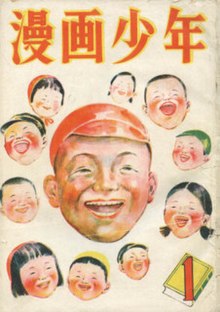Manga Shōnen
 Cover of the inaugural 1947 issue of Manga Shōnen with art by Ichisaburo Sawai | |
| Categories | Shōnen manga |
|---|---|
| Frequency | Monthly |
| First issue | 20 December 1947 |
| Final issue | 1955 |
| Company | Gakudōsha |
| Country | Japan |
| Based in | Tokyo |
| Language | Japanese |
Manga Shōnen (漫画少年) was a monthly manga magazine published by Gakudōsha between December 1947 and October 1955.[1] The magazine was important in forming and promoting shōnen manga in post-war Japan.[2]
Legacy
The magazine was first published on 20 December 1947.[3]
The magazine under the editorship of Kenichi Katō motivated its readers in its unique "readers section" to send in their own comics to the magazine for competitions.[4] Many new artists emerged due to this; for example Yoshihiro Tatsumi and Hideko Mizuno at a young age sent in manga to competitions of the magazine.[1][5] Young artists published in the magazine were often contacted by other publishers for commissions. Shotaro Ishinomori, Fujiko Fujio, Jirō Tsunoda and Leiji Matsumoto started their professional careers in the magazine.[6] Tezuka founded his magazine COM in 1967 with the intention to give space for new manga artists to experiment, like Manga Shōnen had been during its existence.[7]
The magazine managed to capture the new graphic developments of story manga, as it was popular in the Osaka-based akahon market and gained a big readership. Kenichi Katō had previously been the editor of the popular boys magazine Shōnen Club at Kodansha and had good connections to some of the most popular artists at the time.[5] Kimba the White Lion by Osamu Tezuka was the most popular series from the magazine.[6]
Features
Among the series featured in the magazine were:
- Bat Kid by Kazuo Inoue and Eiichi Fukui (1947-1949)[8]
- Kimba the White Lion by Osamu Tezuka (1950-1954)
- Manga Classroom by Osamu Tezuka (1952-1954)[9]
- Donmai-kun (ドンマイ君) by Eiichi Fukui
- Phoenix by Osamu Tezuka (1954-1955)
- Nikyū Tenshi (二級天使) by Shotaro Ishinomori (1955)
References
- ^ a b Iadonisi, Richard (2012). Graphic History : Essays on Graphic Novels And/As History. Newcastle upon Tyne: Cambridge Scholars Pub. ISBN 978-1-299-65892-9. OCLC 823721182.
- ^ McCarthy, Helen (2014). A brief history of manga : the essential pocket guide to Japanese pop culture. Lewes, East Sussex [England]. ISBN 978-1-78157-098-2. OCLC 851826978.
{{cite book}}: CS1 maint: location missing publisher (link) - ^ "漫画少年 昭和23年1月 創刊号1947(S22)12.20". ekizo.mandarake.co.jp. Retrieved 2022-10-08.
- ^ Stewart, Ronald (2022). Manga : a critical guide (1st ed.). London [England]. ISBN 978-1-350-07238-1. OCLC 1290324626.
{{cite book}}: CS1 maint: location missing publisher (link) - ^ a b Power, Natsu Onoda (2009). God of comics : Osamu Tezuka and the creation of post-World War II manga. Jackson [Mississippi]: University Press of Mississippi. ISBN 978-1-60473-478-2. OCLC 472605993.
- ^ a b Kinsella, Sharon (2000). Adult manga : culture and power in contemporary Japanese society. Honolulu. ISBN 0-8248-2317-6. OCLC 42603226.
{{cite book}}: CS1 maint: location missing publisher (link) - ^ "TEZUKA Osamu Manga Museum". Google Arts & Culture. Retrieved 2022-10-08.
- ^ Carey, Ryan. "Bat Kid". The Comics Journal. Retrieved 2022-10-08.
- ^ "Manga Classroom|MANGA|TEZUKA OSAMU OFFICIAL". TezukaOsamu.net(EN). Retrieved 2022-10-09.
